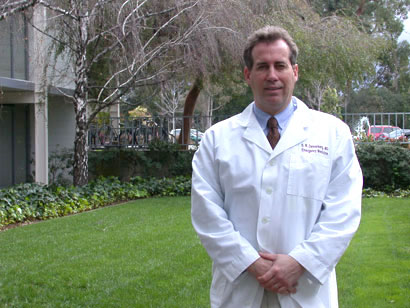Dannenberg
will spearhead effort to enhance emergency care for
children
An eye toward the special needs of kids, new
director will lead pediatric emergency program
By KRISTA CONGER
The emergency room can be a scary place for a
sick young child. Lucile Packard Children’s Hospital and
Stanford Hospital, which share emergency staff and facilities, are
now working to change that feeling.
Construction slated to begin in March in the Emergency Department
of Stanford Hospital will provide a separate, Packard-style,
kid-friendly waiting room stocked with toys, games and videos, as
well as an additional seven examination rooms designed and
decorated with kids in mind and supplied with scaled-down medical
instruments to improve patient care.
“We know that treating children can be different from
treating adults,” said Bernard Dannenberg, MD.
“Children who need emergency care are often frightened and
their families are stressed. There’s lots of anxiety.
Creating a child-friendly environment will allow us to better treat
these patients.”
Dannenberg, who arrived at Stanford Feb. 2, is Packard’s
first Davies Family Endowed Director of Pediatric Emergency
Medicine. He has the rare distinction of completing two medical
residencies: pediatric medicine and emergency medicine.

Bernard Dannenberg is the
first Davies Family Endowed Director of Pediatric Emergency
Medicine at Packard Children’s Hospital. He will oversee the
pediatric emergency program at the medical center.
Photo: Krista Conger
“We specifically looked for someone who had completed both
residencies, rather than a residency followed by a brief
fellowship,” said Robert Norris, MD, Stanford Hospital
emergency medicine chief and associate professor of surgery.
“This allows him to swim in both oceans, so to speak.”
Dannenberg is board-certified in pediatrics, emergency medicine and
pediatric emergency medicine.
Dannenberg most recently served as assistant professor of emergency
medicine and residency director of pediatric emergency medicine at
Loma Linda University Medical Center in Los Angeles. His arrival
and the planned construction reflect Packard Hospital’s
commitment to developing a pediatric emergency program within
Stanford Hospital’s emergency department.
“This is a major step in the evolution of pediatric emergency
medical care for kids in our community,” said Christopher
Dawes, president and CEO of Packard Children’s Hospital.
“Dr. Dannenberg has excellent experience in what has become a
highly specialized field.” Last year the emergency room
served about 10,000 children, and that number is expected to
grow.
“Many of the current emergency room faculty love to see kids
and will continue to do so,” said Norris.
“Everybody who works in the emergency department has
pediatric expertise and experience, but we now want to focus on
some of the unique needs of children.”
Norris and Dannenberg are in the process of recruiting other
pediatric specialists to contribute to the effort.
“A pediatric nurse educator is already on-board and soon we
will be adding two pediatric emergency medicine specialists, a
pediatric social worker, and a child life specialist,” said
Dannenberg. All of these people will work together to reassure the
child and the family.
“We are creating an atmosphere that is physically and
emotionally comforting for children,” said Dannenberg.
“All of us who work in emergency medicine are thrilled about
what this means for kids and their families,” said Norris.
“This new department will also enable us to advance the
research and teaching of pediatric emergency medicine through
training programs and fellowships.”
“It’s very exciting to be leading such an important
project,” said Dannenberg. “Packard and
Stanford’s emergency services already provide world-class
care to the community, but now we’re creating a brand-new
standard for children in our community.”

|

